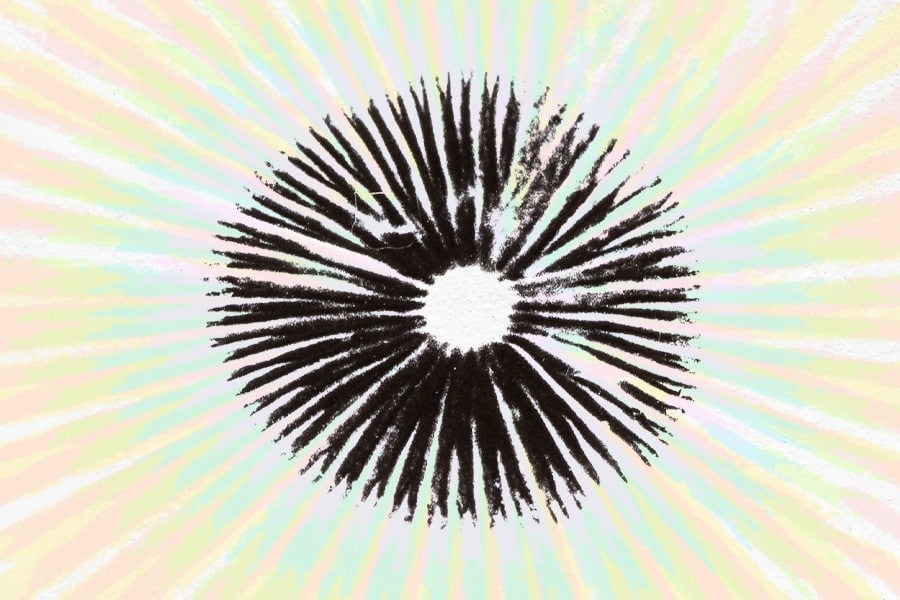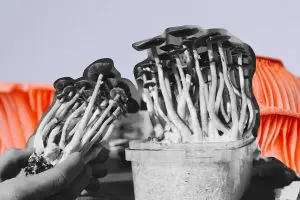A spore is like a seed. As you would collect seeds from plants you grow, or from wild plants, you can collect and store spores from fungi in the form of a spore print. A spore print is formed from the accumulation of spores as they are ejected from the mushroom cap and collect on a surface. You may have noticed the discoloration caused by spores if you ever left a mushroom on a bench, a book, or in a paper bag. Often spores from larger mushrooms are deposited on the caps of smaller mushrooms, making them a different color and leaving some beginner cultivators wondering what has gone wrong!
If you are new to foraging, it is a good practice to do spore prints to aid in identifying the shrooms you have collected. Or if you have successfully grown from a spore syringe and harvested your first mushroom crop, it is recommended to store spores from your cultivated mushrooms—you never know when things are going to go wrong, especially when you are starting!
In this article, we explain how to make spore prints and the best way to store them. Spore prints allow a variety of different methods of propagation. You can wash the spores into water and spread over a substrate, make a spore syringe for use in the PF Tek (a type of mushroom cultivation methodology), or add spores to sterile agar in Petri dishes for more advanced growing techniques.
What is a Spore?
Spores are the fundamental reproductive unit for fungi. They are the primary means by which fungi are distributed—most often cast to the elements, to be swept away on a breeze, caught on the fur of animals, or tramped through the forest on a human’s boot. But unlike a plant seed which contains a complete plant embryo held in a biochemical stasis, a spore is a single haploid cell with a thick hard coating. As spores are incredibly light and durable, they can survive various conditions, including high altitude, the intestinal tracts of animals, and according to some, even outer space!
Also, like seeds, they patiently await the correct environmental or chemical triggers necessary for germination. But unlike plants, germination for spores is a lot riskier. The probability of landing in a suitable substrate in which to germinate—one that is not already colonized by another fungus—and then finding a genetically compatible sexual partner in the same substrate is relatively low. Fungi compensate for this by producing millions of spores per mushroom. When they germinate, the hyphae spread through their substrate, disgesting what they can of their surroundings, but cannot sexually reproduce until they find a compatible mating partner. At that point, the two combine to form a dikaryotic mycelium and complete their life cycle by creating mushrooms and dispersing spores.
All fungi produce spores, but the fungi that produce mushrooms fit into two groups: the Ascomycota and the Basidiomycota. The two groups are classified by their spore dispersal methods. Ascomycota form their spores in long thin tubes called asci (plural of ascus). The asci are distributed across the surface of the mushroom, the pressure in the tubes build up and the spores are shot into the air. The most well known Ascomycota include some cup fungi, and morels (Morchela sp.). The Genus Psilocybe is within the Basidiomycota: Most Basidiomycota form gills or pores, and distributed along the surface of each gill or each pore are structures called basidia (plural of basidium). Spores form on the basidia (usually in groups of four), and in high humidity the spores are catapulted from the mushroom through a process called “ballistospory.”
How to Grow Shrooms Bundle
Take Both of Our Courses and Save $90!
Join Our Community
Psychedelic news delivered right to your inbox, twice monthly.
There is a myth that before you pick a mushroom, you should tap the mushroom cap to knock off all the spores. The spores are firmly attached to the Basidia, and although a few may be dislodged, mushrooms require humidity to eject their spores. Spores have a thin coating of sugar, and in high humidity the sugars help water condense, forming a drop of water at the base of each spore, referred to as Buller’s Drop.The drop of water will keep growing larger till gravity takes over and catapults the spore away from the basidium at an acceleration sometimes exceeding 10 thousand times g (gravity).
How to Make a Spore Print
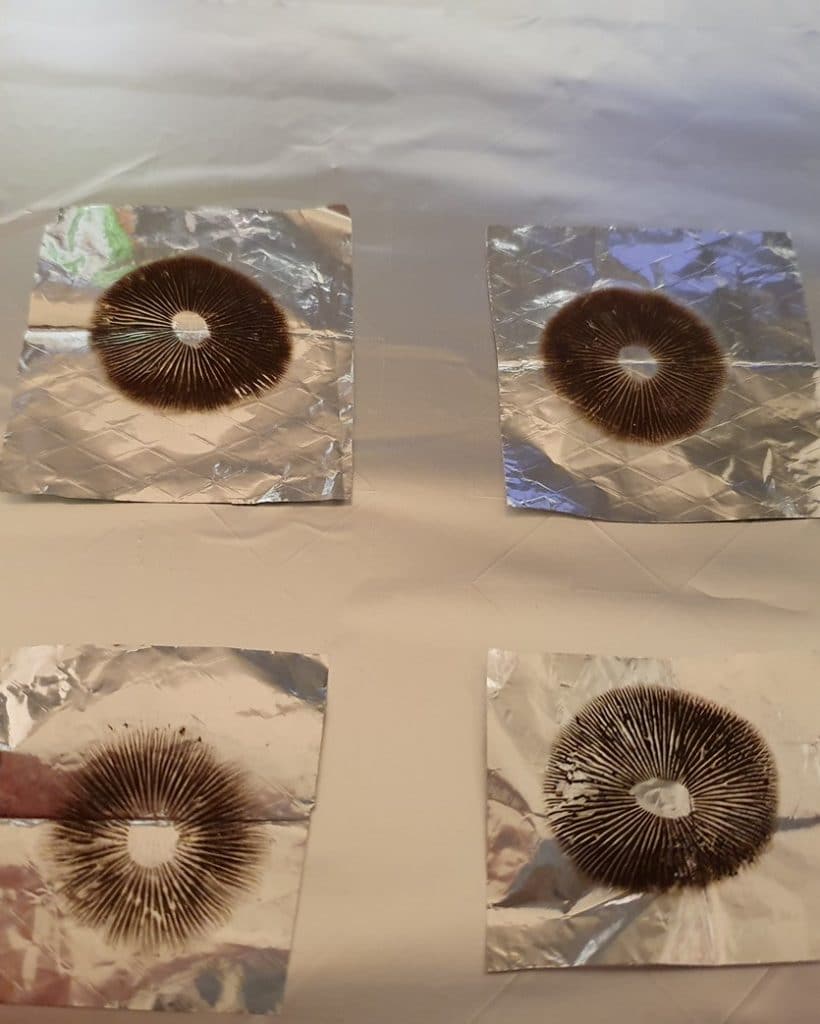
The process of making a spore print is relatively simple. The important thing is you want the print to be as clean as possible—you want to do everything you can to minimize contamination from other fungi spores or bacteria. Contamination is something even agar wizards struggle with, so being clean at this point is vital if you want to save yourself or others (with whom you may be sharing or swapping prints) a lot of headaches. Many cultivators will share stories of contamination issues within mason jars or on agar plates resulting from unclean prints!
If you have a selection of mushrooms to choose from, start with the freshest caps. These should be mushrooms where the caps have recently opened, and the margin of the cap is not fully extended. This can be difficult if you have freshly foraged mushrooms, and it will be a matter of choosing the cleanest specimens. Keep in mind that the older the cap, the fewer the spores and a higher probability of bacteria, other fungi, grubs and insects being present—which, in turn, increases the likelihood of contamination.
Spore prints can be made on a variety of mediums, including black and/or white paper, or glass slides. Aluminum foil is the most popular medium; it is cheap, lightweight, won’t smash, and is relatively sterile (if it’s coming straight out of the box; and if you want to go that extra step, you can wipe it down with alcohol beforehand). Paper is problematic for long term storage due to the spores binding with the fibers and the possibility of mites that will munch on your spores.
During the printing process, it is essential to maintain humidity for the spore ejecting mechanisms to work efficiently—you want a thick, dark spore print. The mushroom contains enough moisture (mushrooms are 90 percent water) to maintain humidity. This can be achieved by placing a cup or bowl over the cap during the printing process. The bowl also assists in protecting the area around the cap from dust and other airborne spores. After printing, the spore print needs to dry (any condensation left will promote bacteria).

Spore Print Materials
- alcohol/methylated spirits
- aluminum foil
- cloth
- cup or large bowl
- scalpel or sharp knife
- sealable plastic bag
- torch lighter
- fresh mushrooms.
At worst, all that is needed is two pieces of foil, a cup or bowl, some origami skills, and a pair of scissors. Remember, you want as clean a print as possible. Do this in a location with little airflow, a still air box, a storage box, or in a space in your house that is clean and won’t get disturbed. Rooms like your kitchen are not recommended due to the likelihood of mould spores, especially when you lift the bowl. Remember, the quality of your print will reflect your cleanliness.
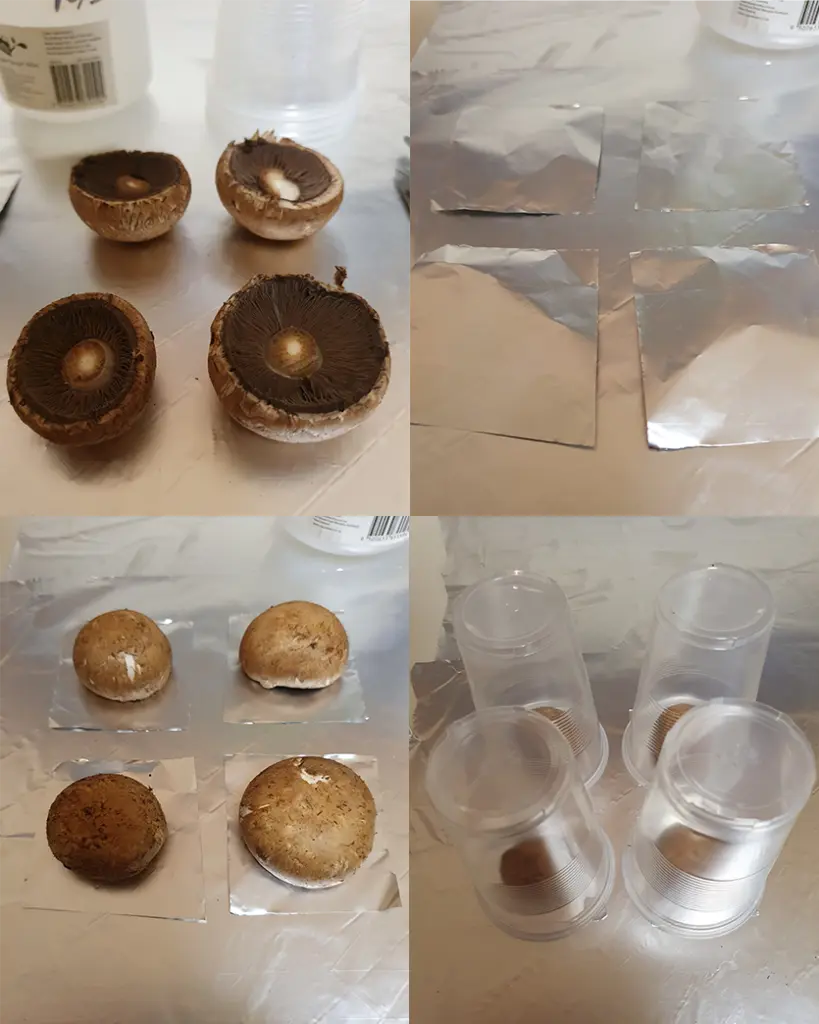
Summarised Steps for How to Make Spore Prints
- Clean everything with alcohol/methylated spirits and let dry
- Lay flat a piece of clean aluminum foil cut to size
- Remove the cap from the mushroom, cutting with a sterile blade as close to the cap as possible. Use the torch lighter to flame the edge of the blade before use.
- Place the cap on the foil gills facing down
- Cover the cap and foil with a cup or bowl
- Leave to sit 6 to 12 hours for a good dark print
- Lift cup/bowl and carefully remove the mushroom cap
- Cover the print with the cup/bowl, and leave for another 6 to 12 hours, or until dry
- Fold and store, use the foil envelope method (described next)
- Date and label the foil pouch.
While waiting for the spore print/s, create an envelope out of the second piece of aluminum foil; fold in half then double fold the edges. This envelope will keep the foil with the print clean while it is in storage, and will help with cleanliness when it comes to making a spore syringe. Be sure to double fold and make the folds clean and tight, as microscopic mites love to eat spores and may in time find their way into the prints.
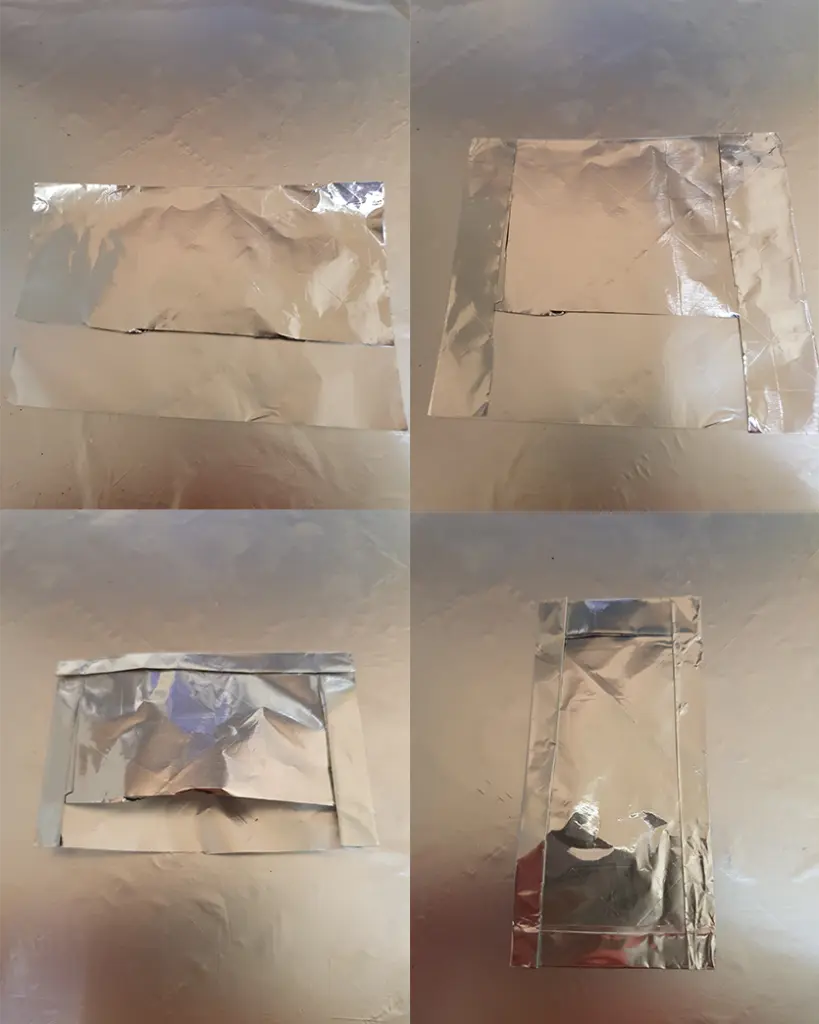
For optimal spore print storage, it is best to store them in a cool dark location, within a self-sealing bag with both oxygen and moisture absorbing satchels. Spores are tough! Really tough! But that doesn’t mean they last forever. Over time they do degrade, so a year or two is the optimal amount of time within which to use them, but after five or six years, you should expect little to no germination.
How to Make a Psilocybe cubensis spore print(vis-a-vis other types of mushroom spore prints)
From a taxonomic perspective, spore prints aid as an additional feature to aid in identification, but by themselves, they cannot alone be used to identify a fungus. All features of the mushroom should be considered together during identification. The stem (stipe), the cap (pileus), the gills (lamellae), the base of the stem with some attached mycelium, and the spore print should all be used. In a lot of cases, observing spores using a microscope is necessary to differentiate some species as they may otherwise look like the same species.
Psilocybe species typically have black-purple spores, but they are not the only genus that can have spore prints of this colour. Some of the poisonous lookalike species (especially among the wood loving species) can have spore prints of a similar enough color to look the same. Hypholoma sp., for example, also have black-purple spores. Meanwhile, other lookalike species such as Galerina and Cortinarius will have rusty brown spores. All good identification guides include the colour of the spore print.
Spore Prints Online
There are many ways to obtain prints online. But before purchasing or swapping spores, be aware of your local laws, which differ among localities, states and countries. Spores of Psilocybin mushrooms fit in a fuzzy legal zone, where you may be able to obtain them legally (“spores for microscopy”), but germinating the spores is illegal—even the intention to grow may be enough to cause problems!
Some countries also have very strict biosecurity laws. For example, importation of Psilocybe spores into Australia is illegal: At a federal level, all parts of a Psilocybe mushroom, including spores, are illegal.
The best place to source spore prints are from online forums, such as The Shroomery or Mycotopia, ethnobotany forums, or ask around on select Reddit or Facebook groups. It is advisable to not ask for spore prints as soon as you join, so be friendly, gain trust, and develop friendships. Stomping in and asking for prints straight of the bat is an excellent way to create suspicion with members and particularly admins.
If you get stuck, some reputable websites sell spores. Seek out other people’s experiences with sellers before you commit. One of the more common sites is Sporeworks.com.
Best of luck with your spore printing. If you want to have some fun, you don’t need to limit yourself to spore printing onto foil, paper, or glass slides; you could print onto items of clothing and spread spores wherever you go! Some people get really creative and use spore prints in art, and even include spores in jewelry.
Interested in having a psychedelic experience, but don't know where to start? Get our definitive guide on trusted legal retreat centers, clinical trials, therapists, and more.
